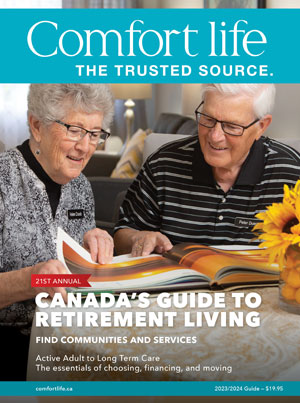What to know about this topic:
- Our contemporary aging couple
- Current living costs
- Sources of funds
- Market value of home
- Two scenarios going forward
- Our previous look at aging at home
In 2011, in Comfort Life magazine and online, we published a look at aging at home, asking whether or not it was really free to live at home. Here, we revisit some scenarios from that article, with updated figures and information for 2017. It's a different world, even from that of six years ago, isn't it?
In that article, we profiled Graham, then 80, and his wife Ethel, then 78, as they negotiated their eldercare journey from being independent at home, through community support then agency support, a live-in caregiver and finally joining a retirement community. The earliest baby boomers are now entering this phase. How will their experience differ, and what can we learn from their approach?
Graham and Ethel were WWI Babies – born in the 1920s – a cohort with traditional values, cost-conscious savers who avoided credit. They regarded their home as their nest egg and were confident that their pensions would ‘see them through’. Their decisions were made in consultation with their adult children and other valued friends.
The baby boomers are less politically, socially and fiscally conservative – think civil rights, 1960’s protesters, women’s rights, gay rights. Their wealth comes most often from savings, equity on the family home in a seller’s market, and company pensions. And they like to make their own decisions, thanks very much.
Our contemporary aging couple
Bob, born in 1940, is an accountant who retired at 70 and started a consulting service helping third-world small-businesses. This entailed worldwide travel, often accompanied by his wife, Diane. In the past few years he’s been diagnosed with rheumatoid arthritis, which is accompanied by iritis (a chronic eye inflammation), intestinal issues and chronic fatigue. However, he continues to play golf with friends, Skype with the grandkids, and follow many online feeds on his iPad. He and Diane love to dine out and attend theatre, and enjoy their urban lifestyle. Based on current life expectancy rates, Bob has a life expectancy of 85 years.
Diane, born in 1942, retired at age 70 from a long career as a hospital administrator. Her enjoyment of golf and yoga has been hampered by joint pain and she is booked for a hip replacement in a few months. Based on the same rates, she can expect to live 90 years.
Current living costs
| ITEM | MONTHLY COST |
| Property tax | $542.00 |
| Utilities | $365.00 |
| General home maintenance | $750.00 |
| Internet, 2 cell phones, long-distance plan | $100.00 |
| Groceries | $700.00 |
| Drugstores | $200.00 |
| Liquor | $250.00 |
| Cars - gas, insurance etc. - 2 cars | $2,400.00 |
| Entertainment - dining, theatre | $500.00 |
| Clothing | $200.00 |
| Sundry cash | $1,200.0 |
| monthly cleaning lady | $100.00 |
| TOTAL MONTHLY COST | $7,307.00 |
A recent BMO Global Asset Management study reports that on average, retired Canadians are spending $2,400 a month – that’s what Graham and Ethel spent, six years ago.
Bob and Diane are able to spend three times that amount. Compared to Graham and Ethel’s monthly budget, the changed values of Bob and Diane’s demographic cohort are evident. Not only are their costs higher, they are different costs – no landline but Wireless for their laptops, cell phones and Skype; more disposable income purchases for restaurants and theatre-going; and generally a more generous lifestyle than Graham and Ethel, a one-income family who counted their pennies. (Pennies are even fading from memory.)
Why is that? Because Bob and Diane have fewer children, with parents who were savers who did well with high interest rates on their investments and passed those savings to their children. Bob and Diane are the first to laud their parents for valuing education and scrimping to send them to university and even graduate school, giving them far better earning power than their parents ever had. Bob and Diane’s household always had two good incomes, and theirs is the last cohort who benefited from one-employer careers with defined-benefit pensions.
Sources of funds
Both Bob and Diane have excellent company pensions. They delayed receiving CPP until age 70; their OAS is clawed back at their income level. They also have extensive investment portfolios - although with far lower interest rates than Graham and Ethel enjoyed – which they had the financial sophistication and confidence to manage over their long working careers. It’s safe to say their monthly expenses are easily covered by their monthly income.
Market value of home
In the hot market of a major urban centre, Bob and Diane’s home has a market value of $875,000, and it's fully paid off. If sold, the proceeds, invested at a conservative 3%, would generate an annual interest income of $26,250 or $2,187 per month.
Bob and Diane are well set, but things can change...
Two scenarios going forward
Our previous look at aging at home
- Aging at Home is Free, Right?
- Aging at Home with Community Support
- Aging at Home with Agency Care
- Aging at Home with Live-in Care
- Aging in Place vs. Moving into a Retirement Home




